Effective Disaster Management Strategies for Tourism Destinations
VerifiedAdded on 2020/11/12
|6
|1379
|391
AI Summary
The report examines the increasing vulnerability of tourism destinations to disasters and crises, highlighting the importance of effective disaster management strategies. It discusses the need for comprehensive frameworks, risk communication, and crisis planning to mitigate the impact of disasters on tourism enterprises and destinations.
Contribute Materials
Your contribution can guide someone’s learning journey. Share your
documents today.
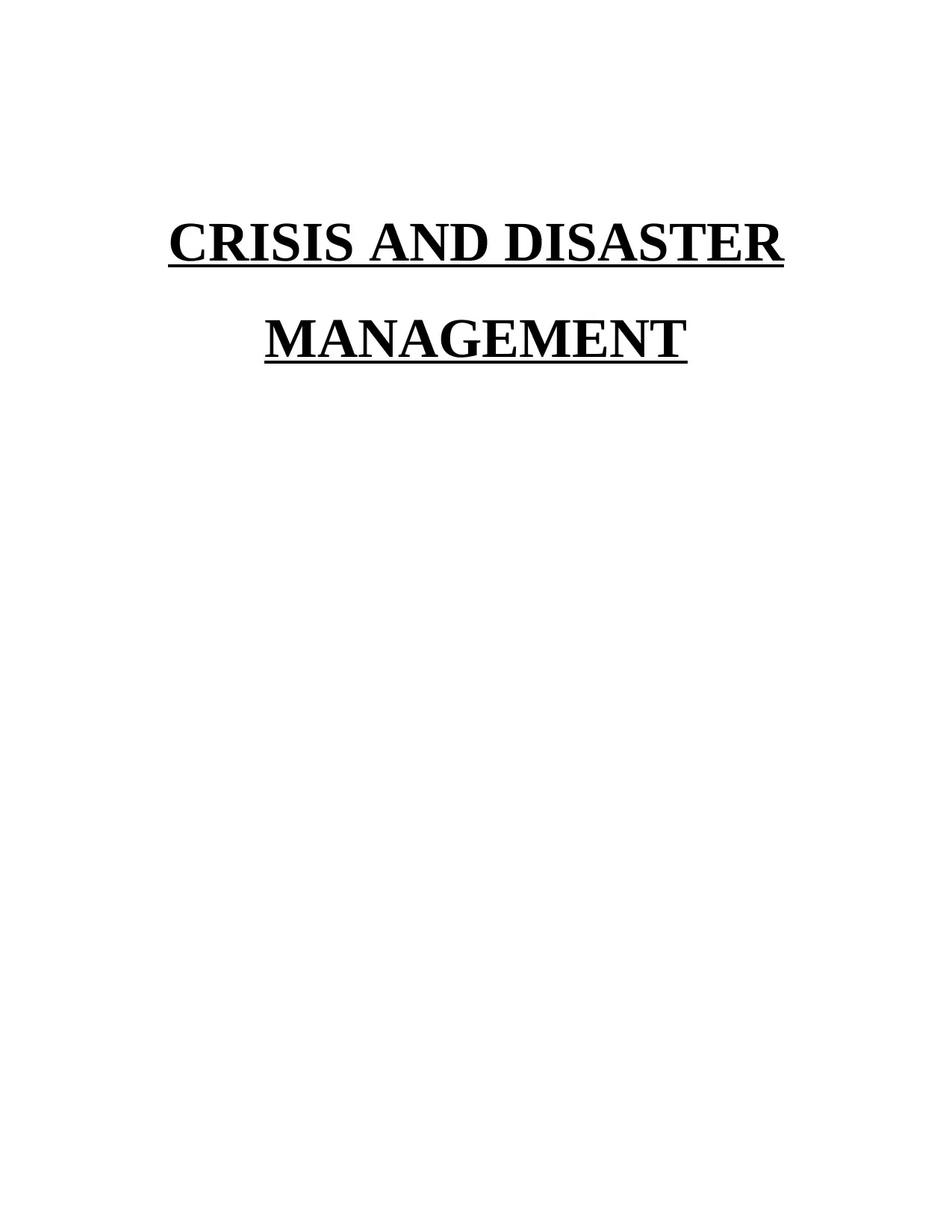
CRISIS AND DISASTER
MANAGEMENT
MANAGEMENT
Secure Best Marks with AI Grader
Need help grading? Try our AI Grader for instant feedback on your assignments.
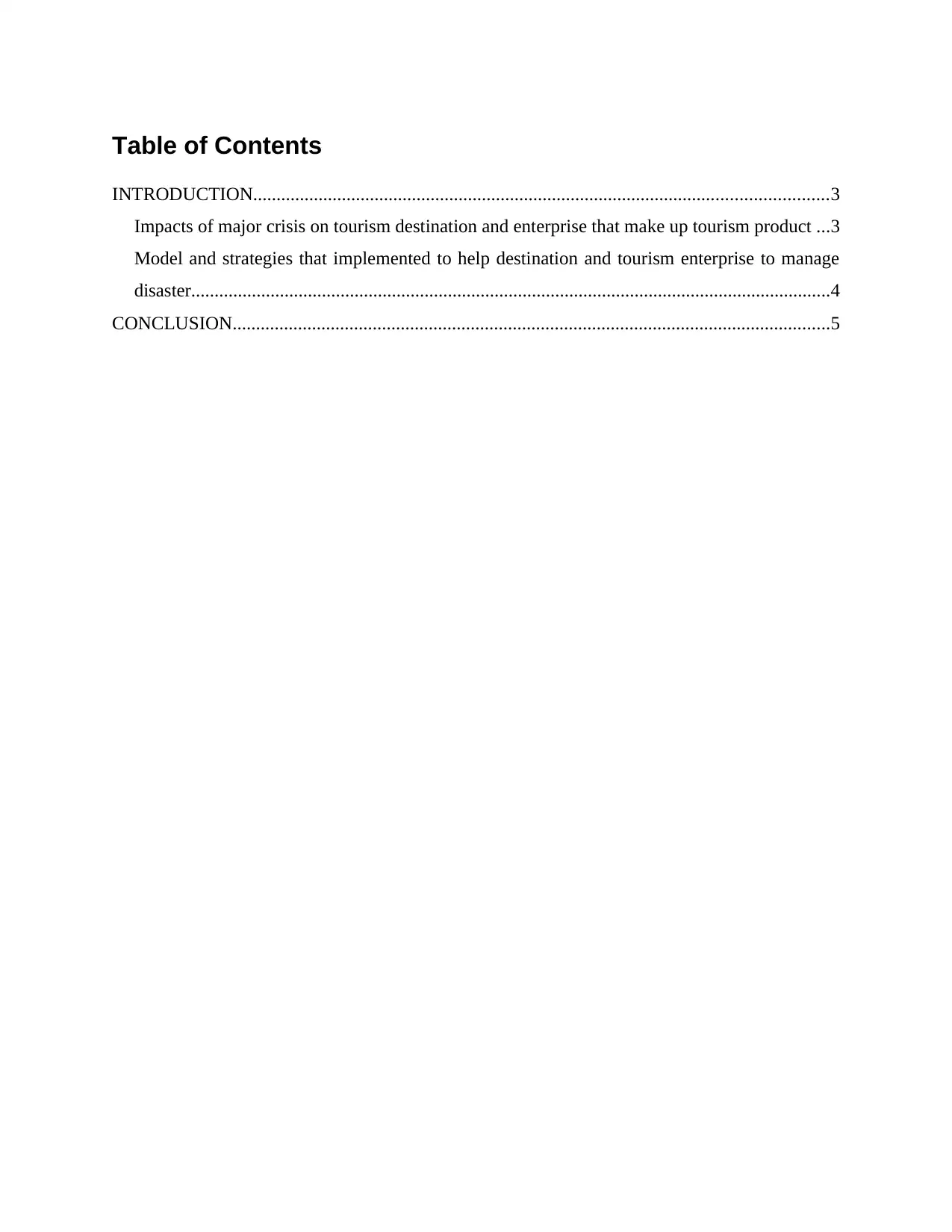
Table of Contents
INTRODUCTION...........................................................................................................................3
Impacts of major crisis on tourism destination and enterprise that make up tourism product ...3
Model and strategies that implemented to help destination and tourism enterprise to manage
disaster.........................................................................................................................................4
CONCLUSION................................................................................................................................5
INTRODUCTION...........................................................................................................................3
Impacts of major crisis on tourism destination and enterprise that make up tourism product ...3
Model and strategies that implemented to help destination and tourism enterprise to manage
disaster.........................................................................................................................................4
CONCLUSION................................................................................................................................5
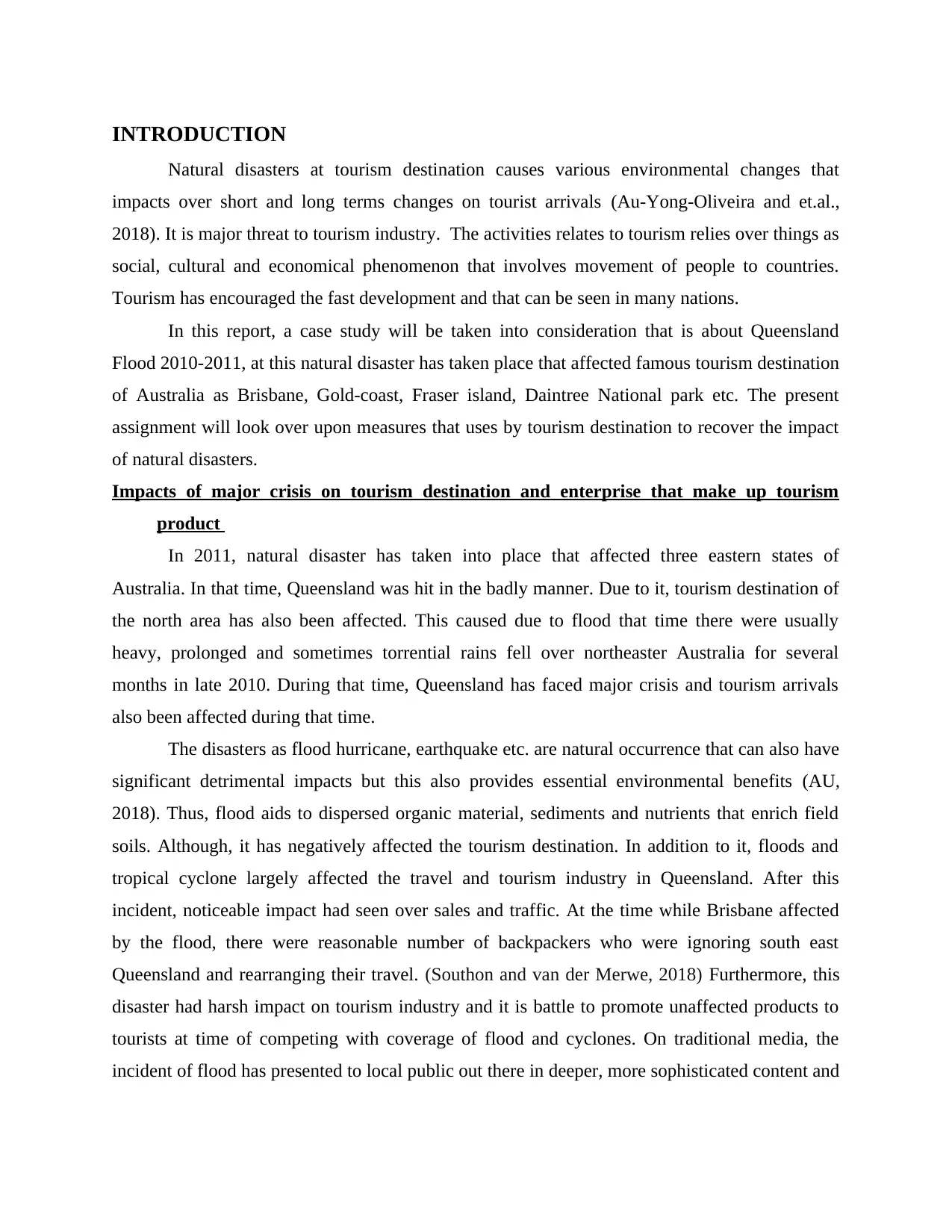
INTRODUCTION
Natural disasters at tourism destination causes various environmental changes that
impacts over short and long terms changes on tourist arrivals (Au-Yong-Oliveira and et.al.,
2018). It is major threat to tourism industry. The activities relates to tourism relies over things as
social, cultural and economical phenomenon that involves movement of people to countries.
Tourism has encouraged the fast development and that can be seen in many nations.
In this report, a case study will be taken into consideration that is about Queensland
Flood 2010-2011, at this natural disaster has taken place that affected famous tourism destination
of Australia as Brisbane, Gold-coast, Fraser island, Daintree National park etc. The present
assignment will look over upon measures that uses by tourism destination to recover the impact
of natural disasters.
Impacts of major crisis on tourism destination and enterprise that make up tourism
product
In 2011, natural disaster has taken into place that affected three eastern states of
Australia. In that time, Queensland was hit in the badly manner. Due to it, tourism destination of
the north area has also been affected. This caused due to flood that time there were usually
heavy, prolonged and sometimes torrential rains fell over northeaster Australia for several
months in late 2010. During that time, Queensland has faced major crisis and tourism arrivals
also been affected during that time.
The disasters as flood hurricane, earthquake etc. are natural occurrence that can also have
significant detrimental impacts but this also provides essential environmental benefits (AU,
2018). Thus, flood aids to dispersed organic material, sediments and nutrients that enrich field
soils. Although, it has negatively affected the tourism destination. In addition to it, floods and
tropical cyclone largely affected the travel and tourism industry in Queensland. After this
incident, noticeable impact had seen over sales and traffic. At the time while Brisbane affected
by the flood, there were reasonable number of backpackers who were ignoring south east
Queensland and rearranging their travel. (Southon and van der Merwe, 2018) Furthermore, this
disaster had harsh impact on tourism industry and it is battle to promote unaffected products to
tourists at time of competing with coverage of flood and cyclones. On traditional media, the
incident of flood has presented to local public out there in deeper, more sophisticated content and
Natural disasters at tourism destination causes various environmental changes that
impacts over short and long terms changes on tourist arrivals (Au-Yong-Oliveira and et.al.,
2018). It is major threat to tourism industry. The activities relates to tourism relies over things as
social, cultural and economical phenomenon that involves movement of people to countries.
Tourism has encouraged the fast development and that can be seen in many nations.
In this report, a case study will be taken into consideration that is about Queensland
Flood 2010-2011, at this natural disaster has taken place that affected famous tourism destination
of Australia as Brisbane, Gold-coast, Fraser island, Daintree National park etc. The present
assignment will look over upon measures that uses by tourism destination to recover the impact
of natural disasters.
Impacts of major crisis on tourism destination and enterprise that make up tourism
product
In 2011, natural disaster has taken into place that affected three eastern states of
Australia. In that time, Queensland was hit in the badly manner. Due to it, tourism destination of
the north area has also been affected. This caused due to flood that time there were usually
heavy, prolonged and sometimes torrential rains fell over northeaster Australia for several
months in late 2010. During that time, Queensland has faced major crisis and tourism arrivals
also been affected during that time.
The disasters as flood hurricane, earthquake etc. are natural occurrence that can also have
significant detrimental impacts but this also provides essential environmental benefits (AU,
2018). Thus, flood aids to dispersed organic material, sediments and nutrients that enrich field
soils. Although, it has negatively affected the tourism destination. In addition to it, floods and
tropical cyclone largely affected the travel and tourism industry in Queensland. After this
incident, noticeable impact had seen over sales and traffic. At the time while Brisbane affected
by the flood, there were reasonable number of backpackers who were ignoring south east
Queensland and rearranging their travel. (Southon and van der Merwe, 2018) Furthermore, this
disaster had harsh impact on tourism industry and it is battle to promote unaffected products to
tourists at time of competing with coverage of flood and cyclones. On traditional media, the
incident of flood has presented to local public out there in deeper, more sophisticated content and
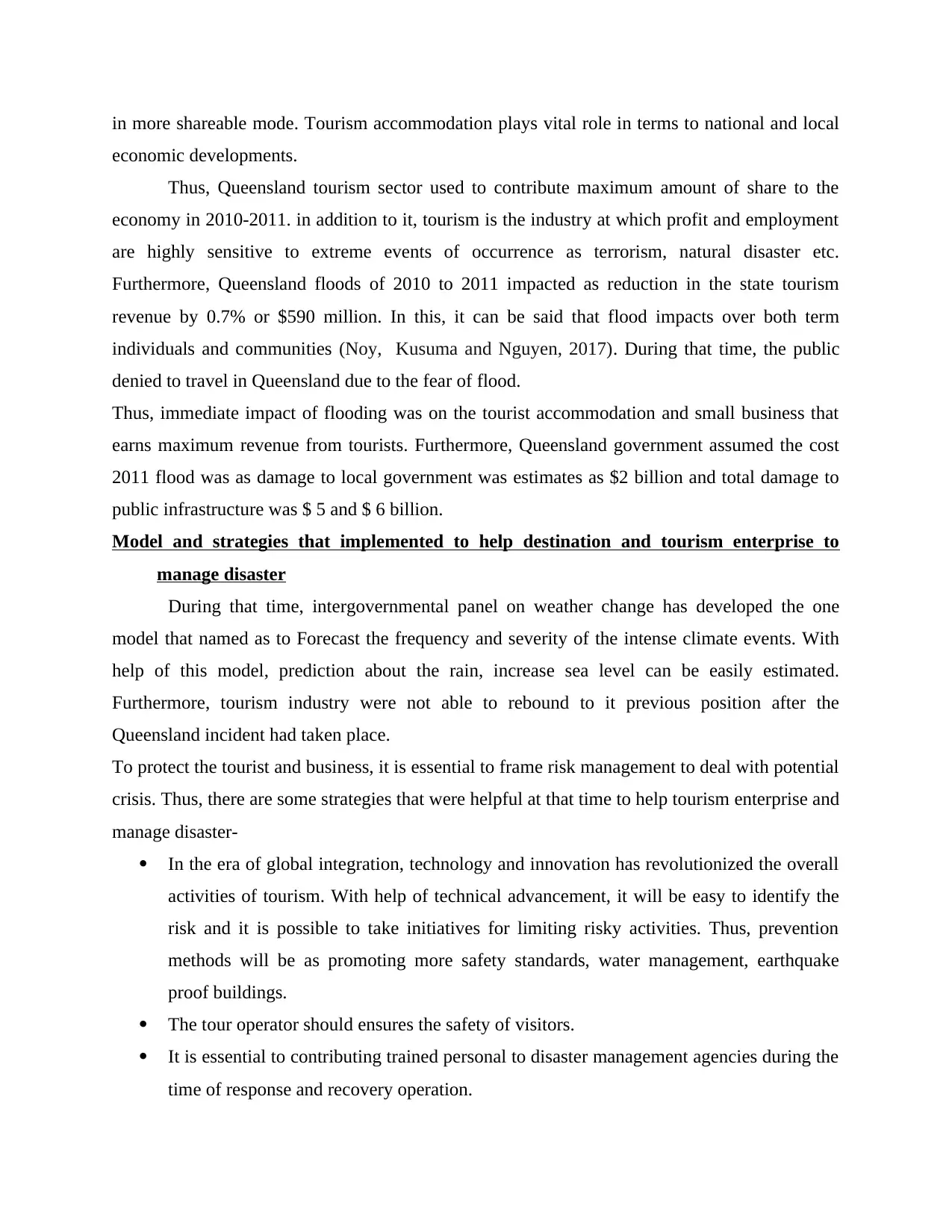
in more shareable mode. Tourism accommodation plays vital role in terms to national and local
economic developments.
Thus, Queensland tourism sector used to contribute maximum amount of share to the
economy in 2010-2011. in addition to it, tourism is the industry at which profit and employment
are highly sensitive to extreme events of occurrence as terrorism, natural disaster etc.
Furthermore, Queensland floods of 2010 to 2011 impacted as reduction in the state tourism
revenue by 0.7% or $590 million. In this, it can be said that flood impacts over both term
individuals and communities (Noy, Kusuma and Nguyen, 2017). During that time, the public
denied to travel in Queensland due to the fear of flood.
Thus, immediate impact of flooding was on the tourist accommodation and small business that
earns maximum revenue from tourists. Furthermore, Queensland government assumed the cost
2011 flood was as damage to local government was estimates as $2 billion and total damage to
public infrastructure was $ 5 and $ 6 billion.
Model and strategies that implemented to help destination and tourism enterprise to
manage disaster
During that time, intergovernmental panel on weather change has developed the one
model that named as to Forecast the frequency and severity of the intense climate events. With
help of this model, prediction about the rain, increase sea level can be easily estimated.
Furthermore, tourism industry were not able to rebound to it previous position after the
Queensland incident had taken place.
To protect the tourist and business, it is essential to frame risk management to deal with potential
crisis. Thus, there are some strategies that were helpful at that time to help tourism enterprise and
manage disaster-
In the era of global integration, technology and innovation has revolutionized the overall
activities of tourism. With help of technical advancement, it will be easy to identify the
risk and it is possible to take initiatives for limiting risky activities. Thus, prevention
methods will be as promoting more safety standards, water management, earthquake
proof buildings.
The tour operator should ensures the safety of visitors.
It is essential to contributing trained personal to disaster management agencies during the
time of response and recovery operation.
economic developments.
Thus, Queensland tourism sector used to contribute maximum amount of share to the
economy in 2010-2011. in addition to it, tourism is the industry at which profit and employment
are highly sensitive to extreme events of occurrence as terrorism, natural disaster etc.
Furthermore, Queensland floods of 2010 to 2011 impacted as reduction in the state tourism
revenue by 0.7% or $590 million. In this, it can be said that flood impacts over both term
individuals and communities (Noy, Kusuma and Nguyen, 2017). During that time, the public
denied to travel in Queensland due to the fear of flood.
Thus, immediate impact of flooding was on the tourist accommodation and small business that
earns maximum revenue from tourists. Furthermore, Queensland government assumed the cost
2011 flood was as damage to local government was estimates as $2 billion and total damage to
public infrastructure was $ 5 and $ 6 billion.
Model and strategies that implemented to help destination and tourism enterprise to
manage disaster
During that time, intergovernmental panel on weather change has developed the one
model that named as to Forecast the frequency and severity of the intense climate events. With
help of this model, prediction about the rain, increase sea level can be easily estimated.
Furthermore, tourism industry were not able to rebound to it previous position after the
Queensland incident had taken place.
To protect the tourist and business, it is essential to frame risk management to deal with potential
crisis. Thus, there are some strategies that were helpful at that time to help tourism enterprise and
manage disaster-
In the era of global integration, technology and innovation has revolutionized the overall
activities of tourism. With help of technical advancement, it will be easy to identify the
risk and it is possible to take initiatives for limiting risky activities. Thus, prevention
methods will be as promoting more safety standards, water management, earthquake
proof buildings.
The tour operator should ensures the safety of visitors.
It is essential to contributing trained personal to disaster management agencies during the
time of response and recovery operation.
Secure Best Marks with AI Grader
Need help grading? Try our AI Grader for instant feedback on your assignments.
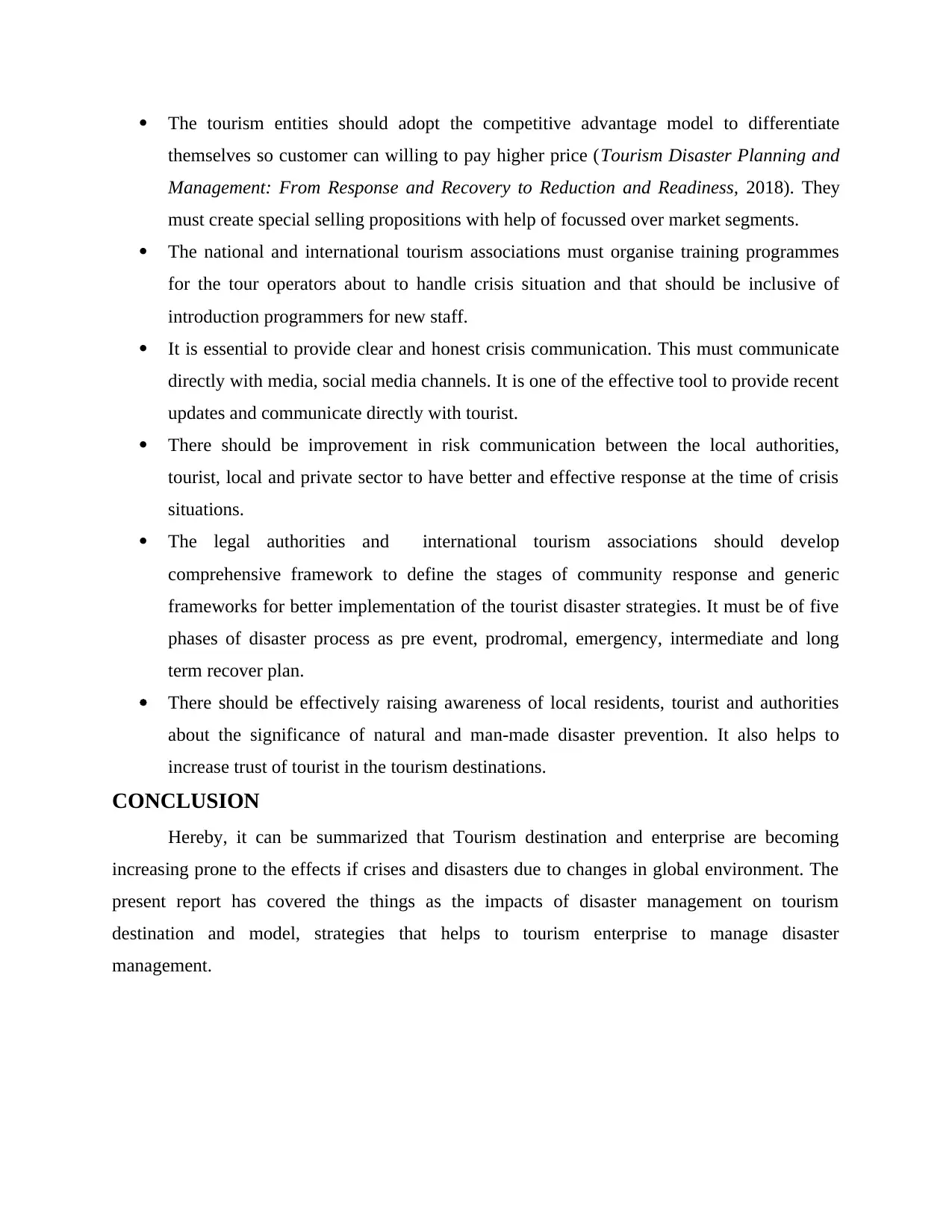
The tourism entities should adopt the competitive advantage model to differentiate
themselves so customer can willing to pay higher price (Tourism Disaster Planning and
Management: From Response and Recovery to Reduction and Readiness, 2018). They
must create special selling propositions with help of focussed over market segments.
The national and international tourism associations must organise training programmes
for the tour operators about to handle crisis situation and that should be inclusive of
introduction programmers for new staff.
It is essential to provide clear and honest crisis communication. This must communicate
directly with media, social media channels. It is one of the effective tool to provide recent
updates and communicate directly with tourist.
There should be improvement in risk communication between the local authorities,
tourist, local and private sector to have better and effective response at the time of crisis
situations.
The legal authorities and international tourism associations should develop
comprehensive framework to define the stages of community response and generic
frameworks for better implementation of the tourist disaster strategies. It must be of five
phases of disaster process as pre event, prodromal, emergency, intermediate and long
term recover plan.
There should be effectively raising awareness of local residents, tourist and authorities
about the significance of natural and man-made disaster prevention. It also helps to
increase trust of tourist in the tourism destinations.
CONCLUSION
Hereby, it can be summarized that Tourism destination and enterprise are becoming
increasing prone to the effects if crises and disasters due to changes in global environment. The
present report has covered the things as the impacts of disaster management on tourism
destination and model, strategies that helps to tourism enterprise to manage disaster
management.
themselves so customer can willing to pay higher price (Tourism Disaster Planning and
Management: From Response and Recovery to Reduction and Readiness, 2018). They
must create special selling propositions with help of focussed over market segments.
The national and international tourism associations must organise training programmes
for the tour operators about to handle crisis situation and that should be inclusive of
introduction programmers for new staff.
It is essential to provide clear and honest crisis communication. This must communicate
directly with media, social media channels. It is one of the effective tool to provide recent
updates and communicate directly with tourist.
There should be improvement in risk communication between the local authorities,
tourist, local and private sector to have better and effective response at the time of crisis
situations.
The legal authorities and international tourism associations should develop
comprehensive framework to define the stages of community response and generic
frameworks for better implementation of the tourist disaster strategies. It must be of five
phases of disaster process as pre event, prodromal, emergency, intermediate and long
term recover plan.
There should be effectively raising awareness of local residents, tourist and authorities
about the significance of natural and man-made disaster prevention. It also helps to
increase trust of tourist in the tourism destinations.
CONCLUSION
Hereby, it can be summarized that Tourism destination and enterprise are becoming
increasing prone to the effects if crises and disasters due to changes in global environment. The
present report has covered the things as the impacts of disaster management on tourism
destination and model, strategies that helps to tourism enterprise to manage disaster
management.
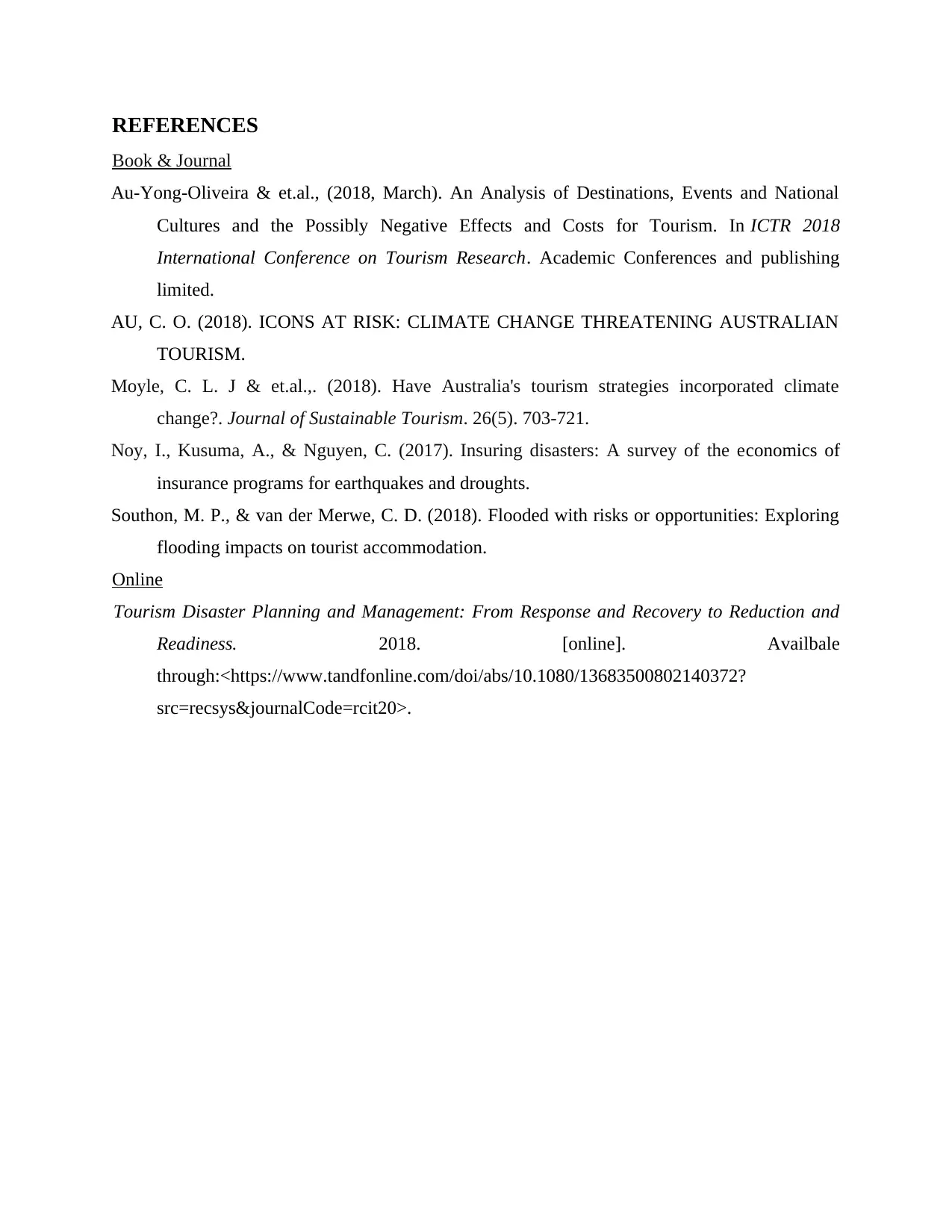
REFERENCES
Book & Journal
Au-Yong-Oliveira & et.al., (2018, March). An Analysis of Destinations, Events and National
Cultures and the Possibly Negative Effects and Costs for Tourism. In ICTR 2018
International Conference on Tourism Research. Academic Conferences and publishing
limited.
AU, C. O. (2018). ICONS AT RISK: CLIMATE CHANGE THREATENING AUSTRALIAN
TOURISM.
Moyle, C. L. J & et.al.,. (2018). Have Australia's tourism strategies incorporated climate
change?. Journal of Sustainable Tourism. 26(5). 703-721.
Noy, I., Kusuma, A., & Nguyen, C. (2017). Insuring disasters: A survey of the economics of
insurance programs for earthquakes and droughts.
Southon, M. P., & van der Merwe, C. D. (2018). Flooded with risks or opportunities: Exploring
flooding impacts on tourist accommodation.
Online
Tourism Disaster Planning and Management: From Response and Recovery to Reduction and
Readiness. 2018. [online]. Availbale
through:<https://www.tandfonline.com/doi/abs/10.1080/13683500802140372?
src=recsys&journalCode=rcit20>.
Book & Journal
Au-Yong-Oliveira & et.al., (2018, March). An Analysis of Destinations, Events and National
Cultures and the Possibly Negative Effects and Costs for Tourism. In ICTR 2018
International Conference on Tourism Research. Academic Conferences and publishing
limited.
AU, C. O. (2018). ICONS AT RISK: CLIMATE CHANGE THREATENING AUSTRALIAN
TOURISM.
Moyle, C. L. J & et.al.,. (2018). Have Australia's tourism strategies incorporated climate
change?. Journal of Sustainable Tourism. 26(5). 703-721.
Noy, I., Kusuma, A., & Nguyen, C. (2017). Insuring disasters: A survey of the economics of
insurance programs for earthquakes and droughts.
Southon, M. P., & van der Merwe, C. D. (2018). Flooded with risks or opportunities: Exploring
flooding impacts on tourist accommodation.
Online
Tourism Disaster Planning and Management: From Response and Recovery to Reduction and
Readiness. 2018. [online]. Availbale
through:<https://www.tandfonline.com/doi/abs/10.1080/13683500802140372?
src=recsys&journalCode=rcit20>.
1 out of 6
Related Documents
Your All-in-One AI-Powered Toolkit for Academic Success.
+13062052269
info@desklib.com
Available 24*7 on WhatsApp / Email
![[object Object]](/_next/static/media/star-bottom.7253800d.svg)
Unlock your academic potential
© 2024 | Zucol Services PVT LTD | All rights reserved.




